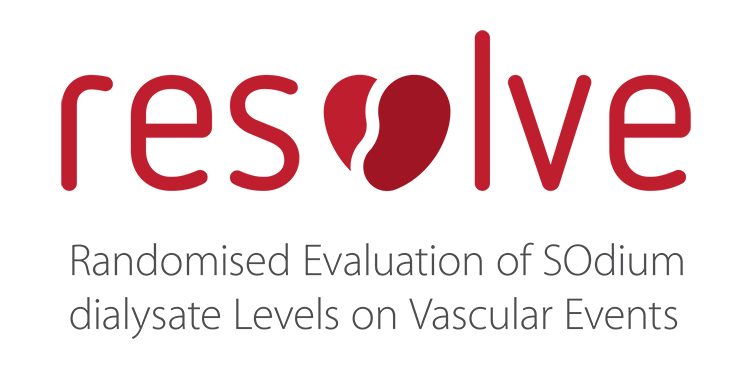
Randomised Evaluation of Sodium Dialysate Levels on Vascular Events (RESOLVE)
Chronic kidney disease is increasing globally in line with the rise in the prevalence of diabetes, high blood pressure and obesity, and falls in acute illness mortality. Life can be sustained for those with advanced kidney disease through Renal Replacement Therapy (dialysis or kidney transplantation) although patient survival is poor. Rates of death are 10 to 100 times higher than the general population, with at least half of all deaths due to cardiovascular (CV) disease.
The atypical features of cardiovascular disease in dialysis patients suggest processes at play beyond the pathophysiological processes of traditional vascular disease. The different nature of cardiovascular disease in dialysis patients is illustrated by the prevalence of left ventricular remodelling and the high rates of sudden cardiac death (SCD). Left ventricular remodelling is a common among dialysis patients and is a strong predictor of overall mortality and particularly of SCD in ESRD patients . SCD is more frequent cause of cardiovascular death among dialysis patients compared with the general population (26% compared with 6- 13% respectively). SCD in dialysis patients is associated with factors such as left ventricular overload, vascular calcification, intradialytic hemodynamic events and cardiac electrophysiological variation [7] with only a minority of cases associated with evidence of coronary artery disease unlike the general population.
A major aetiological driver of this pathway appears to be sodium and fluid retention. The inevitable consequence of the impaired sodium excretion associated with advanced and end stage kidney disease is retention of sodium and fluid which is near ubiquitous with current dialysis technology. The resultant expansion of extracellular fluid results in high blood pressure, increased vascular volume and cardiac stretch leading to left ventricular remodelling.
Mechanisms of reducing sodium and fluid overload are thus a priority. Dietary sodium reduction is widely advised but is difficult to achieve. A clear modifiable source of sodium exposure in dialysis patients is to dialysate sodium (DNa+) during haemodialysis (HD) treatment. Reducing sodium exposure during dialysis is a promising intervention that may reduce cardiovascular mortality.
Aim:
This international study will establish whether for patients receiving maintenance haemodialysis in centres employing a default DNa+, treatment in a centre with default DNa+ of 137 mmol/l compared with 140mmol/l reduces major cardiovascular events and death.
Research Methodology:
RESOLVE is a pragmatic, cluster-randomised, open-label trial designed to evaluate in real-world conditions the comparative effectiveness of two default dialysate sodium concentrations.
Dialysis sites will be randomised in a 1:1 ratio to a default dialysate sodium concentration of 137mmol/l or 140mmol/l. 'Default' is defined as the use of the allocated dialysate sodium for ≥ 90% of delivered dialysis sessions in the unit. All other care will be according to standard local practices as determined by the site.
Outcomes will be assessed on individual patients dialysing at those sites. Sites will be asked to consent to participation while waiver or opt-out consent will be sought for individual patients.
It is anticipated that site accrual will occur over 2-5 years with average study duration expected to be approximately 5 years. The actual length of the study will be end-point determined.
The study will involve a staged roll-out. The initial Development Phase will ascertain the feasibility of implementing the study protocol. The vanguard phase will continue to implement the protocol and allow testing of study assumptions. The main phase will conclude the study.








